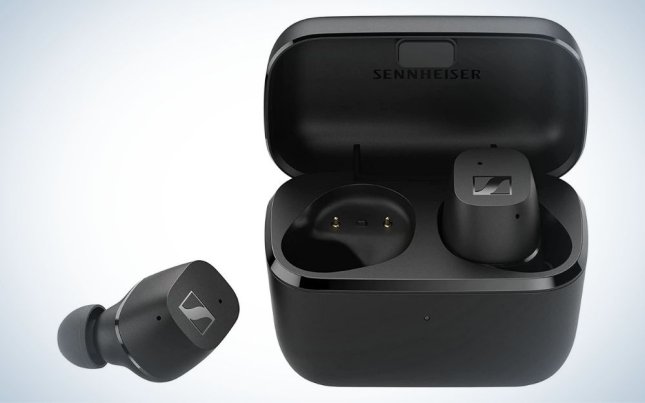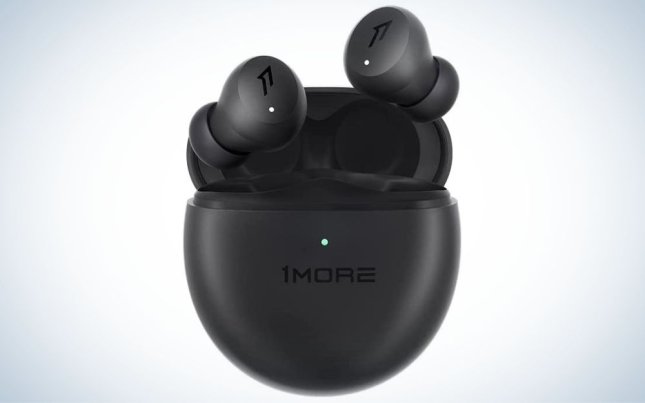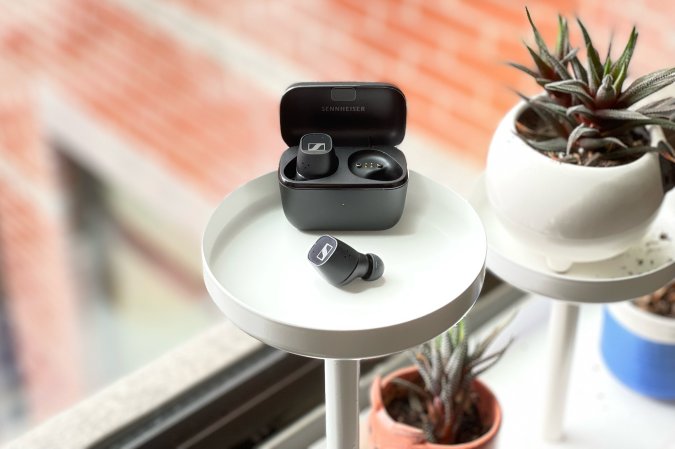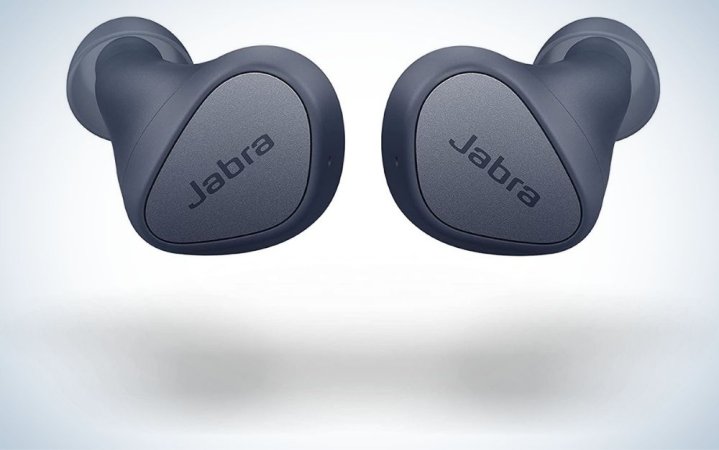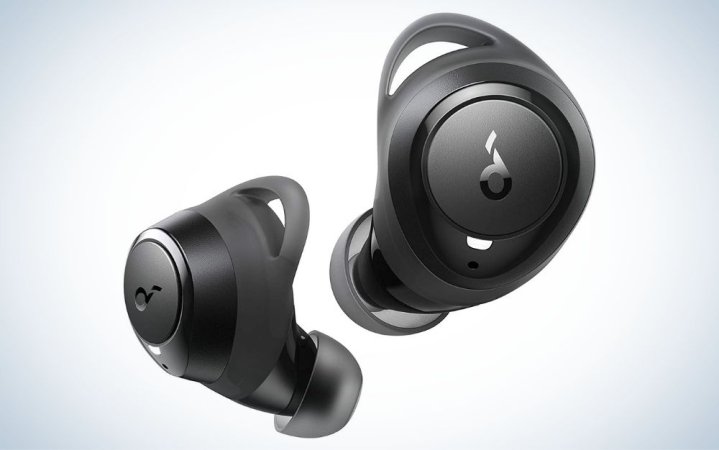We may earn revenue from the products available on this page and participate in affiliate programs. Learn more ›
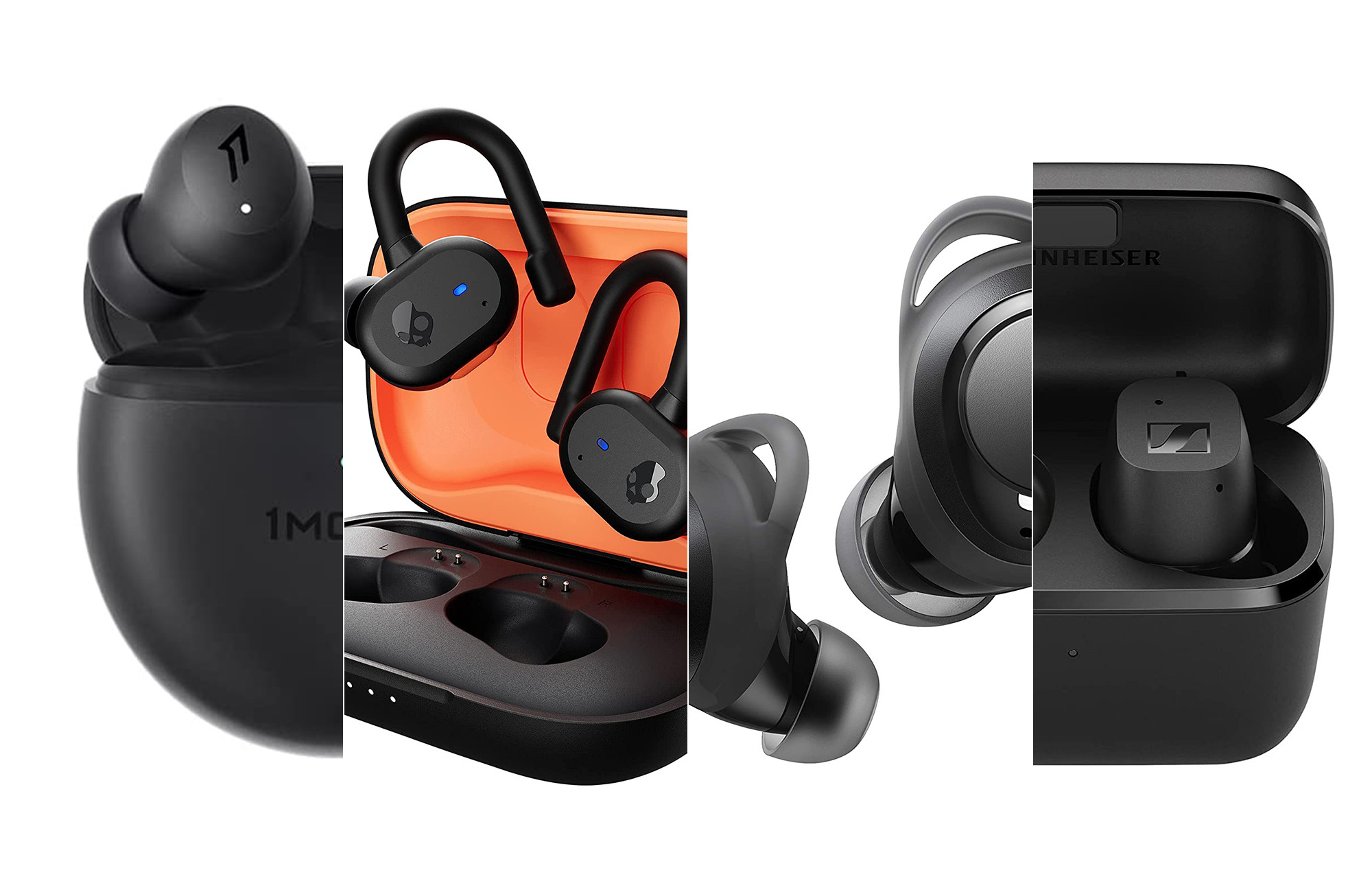
When looking for budget wireless earbuds, you’re looking not just for a low price but also for genuine value. If the lowest cost were your main concern, why would you care about reviews? Truly terrible wireless earbuds are available everywhere now: grocery stores, gas stations, even vending machines. It’s the marriage of quality and cost that truly makes a purchase feel great, and hearing news of a brand that gives you so much more than it asks for in return is music to the value-minded listener’s ears.
So ear’s the deal: every one of the sets below is a worthy pocketmate for your melodious sojourns. They’ll be great friends to you on the subway or bus during a commute, while you jog in nature or on a machine in the gym, and while you tune out the hustle and bustle while you work. They are the best buds, for the best price. So listen up and learn how to get that kind earbud, here or there or anywhere, without breaking the bank. These are the best wireless earbuds under $100.
- Best overall: Sennheiser CX True
- Best noise-canceling: 1MORE ComfoBuds Mini
- Best for calls: Jabra 3 Elite
- Best for exercise: Anker Soundcore Life A1
- Best budget: Skullcandy Push Active
How we selected the best wireless earbuds under $100
We only have two ears each, but we listen to everyone. Using a combination of personal experience, testimonials from colleagues, friends, and family, as well as reviews and opinions from around the internet, we’ve come up with a list that lets us recommend the best ‘buds to our buds. Oh, and of course, nothing is allowed on the list if it’s not available for under $100 at publication.
Best wireless earbuds under $100: Reviews & Recommendations
With the right earbuds, you can be a buddy to your ears.
Best overall: Sennheiser CX True
Best overall
Pros
- Support for higher-quality Bluetooth codecs (AAC, aptX, SBC)
- Equalization features and customization target audiophiles
- Smart control app for iOS or Android
Cons
- Lower IP rating means they’re not fully protected for outdoor use or exercise
- Charging case doesn’t afford as many extra hours as some other brands
Why it made the cut: The German audio brand to beat has been working for years to lower the cost of entry for their products, and they’ve done a great job of it.
Specs
- Bluetooth: 5.2
- IP Rating: IPX4
- Battery Life: 9 hours (playback) + 18 hours (charging case)
- Charging: USB-C
Sennheiser is a common name on “best of” lists (such as our own mixing headphones), but until recently the venerable German concentrated on the high-end, high-cost product categories. No more. The venerable audio powerhouse has begun to offer excellent products that put sound quality first all up and down the line, in all styles. As with Sennheiser’s headphones, soundbars, etc., the company’s true wireless earbuds are a cut above the rest of the sub-three-figures competition, featuring support for the Bluetooth codecs that matter in today’s streaming game: aptX, AAC, and SBC.
Better codecs ensure rich, expressive playback of streamed audio, whether it’s lossless Apple Music albums or Spotify playlists that slap. While streams—and wireless—will never eclipse analog audio (for that check out Sennheiser’s addictive IE300 and immersive IE900), the gulf in quality is as narrow as its ever been while the CX True’s frequency range is a wide 5 Hz – 21,000 Hz.
Battery life is strong on the CX True, with 9 hours of playback, 50% more than a lot of buds. However, the charging case doesn’t provide quite as much backup juice as others do. 18 extra hours are welcome, but many on the market offer over a day of extra power in their charging cases. However, because the charging case doesn’t have as large a battery housed in it, it also is smaller and sleeker and fits in a jeans pocket more easily than some other, bulkier-but-with-more-juice brands do.
Fit is good on the Sennheiser. The squared housing isn’t the most comfortable on the market, but they have a good hold, aren’t too weighty, and look nice. While IPX4 does protect the earbuds from water somewhat, you won’t want to subject these to marathon sweat seasons or extended elements (Sennheiser also makes the Sport True with IP54, but it’s not under $100). However, you don’t buy Sennheiser solely for the aesthetics of the device as much as the aesthetics of the sound. Sennheiser offers more customization options than its competitors, including a well-pointed app for Android or iOS. And these settings aren’t just lip service. The superior sound quality from the 7mm TrueResponse transducers (a driver shared across far more expensive models) is immediately recognizable when you adjust the levels to your liking.
The noise cancellation on these is passive only, but active noise cancellation is hard to come by under $100 anyway (Sennheiser’s own ANC version, the CX Plus True, can be had for $130). Sennheiser takes the crown among wireless earbuds through its best-in-class sound. Technically, the CX True retails for $130, but it is almost always available from online retailers, including Amazon, for slightly under $100. And, if you want to know more, check out our in-depth review of these earbuds.
Best noise-canceling: 1MORE ComfoBuds Mini
Best noise-canceling

Pros
- Extremely light (3.7g) and small
- SoundID app for customization
- Active noise-canceling adjusts audio in response to outside sound
- Pass-through mode means you don’t have to take the earbuds out to converse
Cons
- Default settings aren’t ideal; must use app for best sound
- Battery life is low (18 hours total with ANC, 24 hours total without)
Why it made the cut: One of the few sub-$100 models to feature active noise canceling, the 1MORE ComfoBuds Mini works great to isolate you in your soundscape.
Specs
- Bluetooth: 5.2
- IP Rating: N/A
- Battery Life: 6 hours (playback) + 18 hours (charging case)
- Charging: USB-C and Qi wireless
Big things come in small packages. In this case, the big thing is active noise canceling, which is extremely rare at this price point in true wireless earbuds. The size of the package makes it even more impressive: just 3.7 grams per earbuds. That big feature and that tiny size are what sets the 1MORE ComfoBuds Mini apart.
ANC goes beyond the physical dampening of passive noise-canceling by using external mics and AI software to detect the types of noises that are trying to interfere with your listening and then generate counterwaves to cancel out and compensate for those sounds accordingly. This means that sound itself is creating the barrier, not just the seal on the earbud. When done right, it’s a seamless, incredible technology. Here, the QuietMax ANC promises up to 40dB of environmental reduction—an admirable claim.
It also includes some other noise-maintenance features, such as pass-through mode, which allows announcements or conversations to come through the earbuds even when they’re in your ears. WNR (Wind Noise Resistant) automatically suppresses the low whirr of wind. The ANC has two settings: Strong and Mild. Experimenting with these will let you know which is more comfortable for you in your environments, and will also show you how the sound profile shifts with each one. Strong is for noisy places like airports and public transit, while mild is designed for an office or cafe.
Unfortunately, because of its small size and demanding tech, the battery life on these suffers. With ANC on, you get 5 hours of active listening plus another 13 from the charging case. (That jumps to 6 and 18 with ANC off.) Thankfully, charging (USB-C or Qi) is fast, with 10 minutes of charge producing 90 minutes of playback.
Sound-wise, these ’buds can be small but mighty … if you take a few simple steps. The stock tuning isn’t the most punchy. But, luckily, there’s a lot of personalization through the paired SoundID app, which lets you take a short test and then apply a custom EQ to your earbuds. You can really improve the overall sound quality by carefully considering the options in a quiet space and finding your sweet spots. If active noise-canceling and a small, comfortable fit are most important to you, the 1MORE ComfoBuds Mini is the best choice in the category. And if you’re willing to step up to slightly larger earbuds and sacrifice wireless case charging, the 1MORE PistonBuds Pro—with its 10mm driver, Bluetooth 5.2 with AAC, and 12 EQ presets—is another competitively priced ANC option.
Best for calls: Jabra 3 Elite
Best for calls
Pros
- Mono mode is a neat trick if you want to share a bud with your bud
- Bass is good
- 4 microphones for high call quality
- Supports aptX codec
- Noise isolation with HearThrough mode option
- Built-in Alexa, Spotify Tap, and Google Fast Pair
Cons
- Cannot switch connections on the fly
Why it made the cut: Comfortable fit, great microphones for calls, and powerful bass make the Jabra 3 Elite an excellent companion.
Specs
- Bluetooth: 5.2
- IP Rating: IP55
- Battery Life: 7 hours (playback) + 28 hours (charging case)
- Charging: USB-C
While most people are looking to listen to music or podcasts with their earbuds, on-the-go type-A girlbosses and boybosses might instead prioritize the call quality that some wireless earbuds afford. Beating the popular Apple AirPods in nearly every call category is the Jabra Elite 3. Both call reception within the earbuds and outgoing voice quality are exemplary thanks to the four onboard microphones, and Jabra consistently wins head-to-head battles when it comes to Bluetooth stability. HearThrough and Mono Mode keep you connected to your surroundings. The Elite 3 also has a noise isolation mode, though it’s not active noise canceling so it tends to be a very flat filter and you will still hear some noise (for ANC you’d have to kick in another $100 for the Elite 7 Pro).
In terms of sound, the bass from the 6mm drivers is pleasingly robust. The Sound+ app that allows you to customize the levels is a must, of course, and it can counteract the relatively low max volume at factory settings. Spotify Tap and Alexa voice assistant compatibility increase the ease of use. Support for the aptX codec means higher quality streaming music on Android alongside those crystal-clear calls.
The main drawbacks of the Elite 3 are the lower water resistance (a rainproof IP55) and the inability to switch connections on the fly. Instead, you have to disconnect and reconnect to any new devices you want to use with these, which can be annoying if you’re coming off a call and want to switch to audio on your laptop. However, as a dedicated companion to a phone, these are excellent.
Best for exercise: Anker Soundcore Life A1
Best for exercise
Pros
- Waterproofing means these can stand up to sweat and/or running through rain
- Fit is snug and comfortable
- 3 preset sound modes
- Great price
Cons
- Sound quality is more mainstream and bass-heavy
Why it made the cut: IPX7 waterproofing means the Anker Soundcore Life A1 will stand up to any amount of sweat or rain when you’re burning those calories.
Specs
- Bluetooth: 5.0
- IP Rating: IPX7
- Battery Life: 9 hours (playback) + 27 hours (charging case)
- Charging: USB-C or Qi wireless
For those of us who need some gym buds, look no further than the Anker Soudcore Life A1. Known initially for its battery packs, Anker has since moved into nearly every conceivable tech space, usually at a lower price point than competitors. Anker’s focus is on daily use rather than pure audiophile sound, which means its products are really easy to integrate and have great battery life but don’t have the lush, fluid playback that something like Sennheiser’s CX True offers.
What Anker did with the Soundcore Life A1, though, is make sure that it created an affordable and durable set of wireless earbuds. IPX7 waterproofing is stronger than others in this category, meaning you don’t have to worry about gym sweat negatively affecting the delicate hardware inside your earbuds. While these earbuds are not particularly small, the fit is snug and comfortable. Once you learn the tap controls there’s a lot you can do while jogging or on the workout machines without grabbing your phone, which is useful to not break your flow. And the 8mm drivers do push plenty of air so you can keep the beat and the pace elevated.
The price point on these—$50—is great, but the compromise is the lack of advanced features such as noise suppression. Bluetooth is 5.0, not 5.2. EQ options are limited to three presets. However, these earbuds are designed to really stand up to daily use. They take a licking and keep on ticking. They don’t have a lot of features beyond that, but the price is right. Snag them on the Anker site.
Best budget: Skullcandy Push Active
Best budget
Pros
- Hands-free voice controls
- Tile finding technology makes them virtually un-loseable
- Spotify Tap compatibility for easy music playback on Spotify
- Dual noise-reduction microphones
- iOS and Android phone control
Cons
- Hook design may not be to your liking
- Sound is good but not top of the heap
Why it made the cut: Comfortable with excellent sound, Skullcandy has grown from a teen-oriented fashion audio brand to a features-first manufacturer, as the Push Active shows.
Specs
- Bluetooth: 5.2
- IP Rating: IP55
- Battery Life: 10 hours (playback) + 34 hours (charging case)
- Charging: USB-C
Our top budget pick could be any number of options from Skullcandy, the Park City, Utah-based company known for the best affordable true wireless earbuds that continually reduce price without cutting features. Skullcandy got its start with lots of flashier skins and colors, offering earbuds that looked cool and had lots of variety. They’ve refocused the brand over the past several years and have started to produce some subtle-but-slick designs that concentrate more on the qualities of the audio, the comfort of the fit, and the tech baked inside the shell.
Let’s start with the Push Active—one of the company’s most recent models and one that stands out by featuring ear hooks for those who like a little more stability in their earbuds, and their workouts. In terms of technology, Bluetooth 5.2 means enhanced compatibility with most devices and stronger audio, and the Tile finding function means that the earbuds can be located wirelessly in case they are ever lost. Spotify Tap allows these earbuds to interact with the listener’s playlists more easily, and both the size (small) and battery life (long) of the charging case are really impressive.
Sound doesn’t reach the rarefied air of a Sennheiser—opting instead for a mainstream-friendly midbass/treble emphasis, aka a V-shaped response—but it is more than adequate. EQ is done through a paired app and there are multiple settings for multiple types of audio (music/podcasts/video). Stay Aware mode detects when someone is trying to talk to you and lowers the volume of what you are listening to so that you can hear. IP55 water resistance offers sweat protection, though it’s not the top level. The 44 hours of battery life and fit, however, may be the real stars of the Push Active.

Skullcandy does offer some other models if you’re looking for particular features. The Push Ultra has a similar form factor and better IP67 water resistance, though that line is due for a refresh. The multitasking-focused $60 Mod is hookless, light, and introduces multipoint pairing at a low price point. The Dime 2 brings true wireless and Tile tracking under $30, and has a small, efficient battery designed to use less power for a small carbon footprint. The $80 Grind Fuel, meanwhile, offers “Skull-iQ”—a system for more in the way of customizable sound and voice controls than most earbuds under $100.
Things to consider before buying wireless earbuds under $100
The main considerations for this list were sound quality, fit, battery life, water resistance, useability, and quality of life features, and the product must have been regularly available for under $100 (even if the suggested retail price were higher). About a dozen different companies’ products were considered, with multiple models in some cases. Ultimately, we weighed sound quality the most, with fit and battery life in the second tier, and useability/quality-of-life features in the third tier, though certain elements were weighed more heavily in certain award categories (such as water resistance in best for exercise).
Fit and style
Typically, wireless earbuds will stay on your ears solely through the small rubber in-ear cups gripping onto the sides of your canal, or there will be a (usually) plastic hook that loops around the ear to help keep the bud from being flung away. The dominant style has become “true wireless,” which means the individual earbuds are not connected to each other via cable. (All of our recommended models are true wireless.) These may or may not have a stem that protrudes (like with Apple’s AirPods 3). True wireless earbuds can be easy to lose but are lighter and more compact than the now less-in-fashion connected wireless earbud style. They come with charging cases that themselves contain a battery. To charge the earbuds, you place them in the case and connect the case to a USB power source. The buds and the backup battery in the case will charge.
Bluetooth
All of the wireless earbuds on our list pair via Bluetooth, an incredibly versatile and widespread radio transmission system that is also not without its flaws. Bluetooth works through software as well as hardware, so if you ever have trouble pairing a set of earbuds, make sure to update any software or drivers on the computer/phone/tablet/television you’re using before blaming the ‘buds.
As the technology develops, Bluetooth also gets more stable over longer distances, so try and get hardware supporting the latest 5.0 revision you can. And, to get the optimal experience, you should pick earbuds that are equipped with the codec that matches your device(s). While Bluetooth everything is universally compatible via the SBC protocol, Apple devices use the AAC format to improve audio, while Android devices adopt aptX for increased fidelity. Some earbuds can support more than one standard, while some can’t. And like sounds best with like, so keep that in mind when shopping.
Audio of choice
Your audio of choice may influence the earbuds that work best for you. Hard-driving bass requires a different soundscape to thrive than, say, a whispery true-crime podcast might. Keep in mind the elements of your most typical audio choices when perusing our recommendations.
FAQs
Anything in our recommended list above is worth buying, but there are some “honorable mentions” that we should, well, mention. The Belkin SOUNDFORM Rise has a great price point and is really solid as an all-around set of stemmed Bluetooth 5.2 earbuds with a pop-friendly kick to the sound. Pretty impressive stuff for a company best known for its charging accessories. The exceedingly light Nothing Ear 1 has a striking minimalist design with Bluetooth 5.2, multiple ANC modes, and an accurate but active tuning by Swedish sound designers Teenage Engineering. And the Cambridge Audio Melomania 1+ has a distinct, comfortable bullet-style design and are extremely compact, with long battery life. They have an expansive, EQ-friendly hi-fi sound profile, if you’re down with the form factor.
One of the best budget brands around is Anker, producers of nearly every type of tech gadget imaginable. Always a great combination of price and quality, Anker is a trustworthy brand when it comes to saving a few bucks without regretting it. Though it didn’t make our list above, the Anker Soundcore Liberty Air 2 is a worthy purchase for an overall strong set of earbuds. If you ever have a technology need, chances are Anker’s got an item to fill it, at a very competitive price.
Yes! Skullcandy got a bit of flack early on in the company’s lifespan for being trendy, a moniker that is a gift (because it means the kids think you’re cool) and a curse (because it means the people who think what the kids think is cool is lame will think you’re lame). Skullcandy didn’t coast on its reputation or still to the mass-market youth sector, though, and really invested in product design, becoming increasingly competitive in both quality and price. Skullcandy has become a brand that can automatically be considered part of the discussion when “best” and “lower price” are being bandied about in the audio space.
Yes. JBL has excellent construction and a lot of innovative ideas about designing fit, to the point that several models could compete for our award for best wireless earbuds for sports under $100. JBL’s audio quality is competitive, the company’s products are attractive and comfortable, and the brand is constantly moving forward and redesigning products, noticing the new features and incorporating them as quickly as possible. JBL earbuds are a very solid contender in the audio space. Our favorites are the JBL Tune 125 TWS, which has excellent bass, and the JBL LIVE 300, which has an equally excellent, and secure, fit.
Final thoughts on the best wireless earbuds under $100
If you’ve decided that true wireless earbuds are the right style and fit for you, and you’re not looking to spend three figures, the good news is that there are a number of excellent options in that category. While the Sennheiser CX True’s sound sets it apart, the features and fits of our other categories do impress. If the next revisions for Sennheiser seek to match those features or the other companies up their sound game, we’ll have a true war to greatness. As it stands, our best wireless earbuds under $100 are all regret-free decisions pushing every cent of value out of your money. Happy listening!
